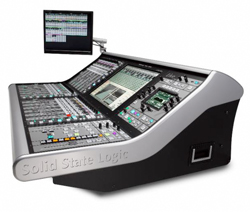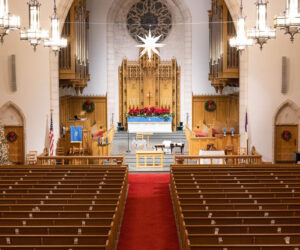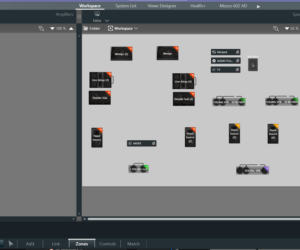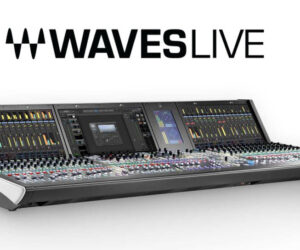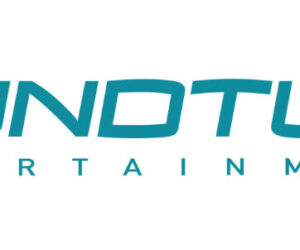Solid State Logic is presenting the SSL Live console range with new V3 software, which introduces over 40 software and hardware features, at the ongoing InfoComm 2015 show in Orlando (booth 579).
In addition, the L500 now becomes the L500 Plus to mark the ongoing evolution of the console and increasing the power from 192 mix paths to 256, with a doubling of effects processing power (depending on the effects selected). The L300 also offers a power increase from 128 to 192 mix paths.
SSL Live V3 software is now standard on all new consoles, while upgrades are available to existing consoles.
V3 also provides the new Super-Q feature, an optional Dante interface card, Remote Control software, Console Expander Mode, user interface changes, new effects, enhancements to the solo system, as well as a collection of features designed for customers who broadcast their productions.
Dante Interface Option
A new Dante card option offers up to 32 x 32 channels of I/O at 96 kHz over a redundant Dante connection. The card can be set to operate at 48 kHz or 96 kHz independently of the rest of the console. The card expands the maximum inputs and outputs for SSL Live consoles from 568 to 600 for an L300 and from 976 to 1008 for an L500 Plus.
Console Expander Mode
Where two operators wish to control the same audio environment, or when more physical faders are required, a second console may be connected to the main console. This expands the control surface available and allows multiple surfaces to share the processing and I/O power of the main console. The active automation scene is automatically synchronised between the two control surfaces for simultaneous but independent control.
Super-Q
Super-Q is the next generation of Live’s Query function, offering unprecedented workflow flexibility from the touch of a single button. Just like the original Query function, Super-Q allows the user to ‘spill out’ the contributing elements or destinations for a selected fader/path across the control surface. Pressing a channel’s ‘Q’ button shows the mix busses to which the channel is routed. Querying a mix bus will show only the channels that are contributing to that mix. Pressing a VCA’s Q button will show all channels under its Control.
Super-Q also shows the send levels to and from mixes, allowing instant and accurate mix control, either from a channel- or mix-centric view. These contributions can be displayed either on the rotary encoders at the top of each fader strip, or automatically ‘flipped’ onto the faders.
Super-Q has two modes: ‘Compressed’ mode shows a focused view of only the audio paths contributing to or from the queried path, and ‘Expanded’ mode offers user-defined layers and banks, allowing the user to lay out exactly where they want each channel to appear on the surface. The modes are configurable on a per-path type basis, giving the user complete control of their workflow. These new features operate in conjunction with the console’s Follow modes that allow any combination of Select, Solo and Query buttons to be linked.
Remote Control Software
SSL’s SOLSA (SSL Offline Setup Application) software allows creation and editing of Live console showfiles on a laptop, desktop or tablet PC. Almost anything that can be done on a console can be manipulated and configured using SOLSA, including console architecture configuration and setup of Fader Tile Layers and Banks.
Stage boxes and I/O routing can also be assigned along with the creation of scenes and other automation editing. SOLSA also allows you to add effects, manipulate channel processing settings, bus routing and VCA assignments. SOLSA includes the same inline Help System as the Live console software, offering a built-in user guide with tutorials and reference sections.
The SOLSA PC application can be connected to a console using a wired or wireless connection* for real time control of the console from a laptop or tablet PC. SOLSA can also be used ‘offline’ when access to a console is not possible for preparation of show files. *Wireless access point required.
Broadcast Features
V3 software includes a 48kHz mode to facilitate integration. New 5.1 and 4.0 audio path formats have been introduced with all of the necessary routing and monitoring required to support them. The Pan system now includes SSL’s Surround Panner and a selection of the Insert Effects now have 4.0 and 5.1 specific versions. Multichannel Fold-down options have been added with settings available to control the steering logic when routing 5.1 or 4.0 formatted paths onto mono, stereo and LCR buses. Solo Dim mode has been added to the newly enhanced Solo system, which now also includes six external solo sources.
The V3 release also contains a significant collection of individual additions and improvements to the consoles user interface and processing tools. Some highlights include; VCA control of matrix channels, new implementations for the user assignable buttons, a superb new stereo version of the Fixed Point Per Octave Analyser called the FPPO-lyser, which includes a difference mode, allowing the difference between two signals to be monitored and two sets of crosshairs to track the maximum level/frequency and the level of a specific frequency. BPM and Note-based editing has been added to delay modules and stereo channels now have balance and mono sum controls.


